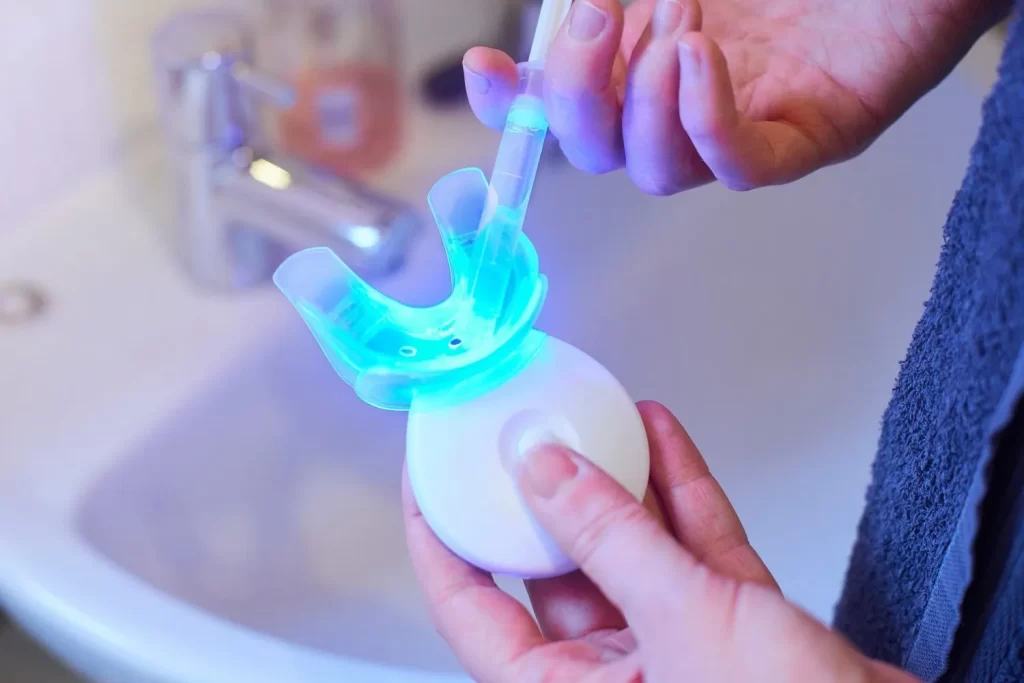How do Teeth Whitening Kits Work to Brighten Teeth?
4 min read
A bright, white smile is often associated with health, youth, and confidence. Teeth whitening kits have become a popular solution for achieving a brighter smile without the need for in-office dental procedures. But how exactly do these kits work to brighten teeth? In this article, we will explore the mechanisms behind teeth whitening kits, discuss their effectiveness, and consider when it might be best to consult a dentist open near you.
The Basics of Teeth Whitening
Teeth whitening is a process that lightens the color of teeth by removing stains and discoloration. The outer layer of the teeth, known as the enamel, can become stained over time due to various factors such as food and drink (like coffee, tea, and red wine), smoking, and poor oral hygiene. Teeth whitening kits work by using bleaching agents to break down these stains, making the teeth appear whiter.
How Teeth Whitening Kits Work
Teeth whitening kits typically contain one of two main bleaching agents: hydrogen peroxide or carbamide peroxide. These chemicals penetrate the enamel to reach the discolored molecules within the tooth. Here’s a step-by-step breakdown of how these kits work:
- Application of Bleaching Agent: The active ingredient in most teeth whitening kits is hydrogen peroxide or carbamide peroxide. When applied to the teeth, these agents release oxygen molecules. This chemical reaction helps break down the bonds of the discolored molecules in the enamel and dentin (the layer beneath the enamel).
- Oxidation Process: The oxygen molecules penetrate the enamel and react with the discolored molecules in the teeth. This oxidation process effectively breaks down the stains into smaller, less pigmented molecules. As a result, the teeth appear whiter and brighter.
- Removal of Stains: Over time, repeated application of the bleaching agent helps to remove deeper stains and discoloration. The frequency and duration of use can vary depending on the specific kit and the desired level of whitening.
Types of Teeth Whitening Kits
There are several types of teeth whitening kits available, each with its own method of application and concentration of bleaching agents:
- Whitening Strips: Whitening strips are thin, flexible plastic strips coated with a layer of bleaching gel. These strips are applied directly to the teeth and left on for a specified period, usually around 30 minutes. They are easy to use and can provide noticeable results in a few weeks.
- Whitening Gels and Trays: Whitening gels are applied to the teeth using a mouth tray. The tray is filled with the gel and worn over the teeth for a designated time, often overnight. These kits can be more effective as the trays ensure even distribution of the bleaching agent.
- Whitening Pens: Whitening pens contain a bleaching gel that is brushed directly onto the teeth. These pens are convenient for touch-ups and can be used in conjunction with other whitening methods.
- LED Light Kits: Some teeth whitening kits include an LED light to enhance the whitening process. The light is believed to activate the bleaching agent, speeding up the oxidation process and improving results.
Effectiveness of Teeth Whitening Kits
The effectiveness of teeth whitening kits can vary based on several factors:
- Concentration of Bleaching Agent: Higher concentrations of hydrogen peroxide or carbamide peroxide generally produce faster and more noticeable results. However, they can also increase the risk of tooth sensitivity and gum irritation.
- Duration and Frequency of Use: Consistent use of the whitening kit as directed is crucial for achieving optimal results. Overuse can lead to sensitivity, while underuse may result in minimal whitening.
- Initial Tooth Color: The starting shade of the teeth can impact the effectiveness of the whitening process. Teeth with yellowish stains tend to respond better to bleaching than those with grayish or brownish discoloration.
- Type of Stains: Extrinsic stains (surface stains) caused by food, drink, and smoking respond well to teeth whitening kits. Intrinsic stains (deep stains) caused by factors such as medication or trauma may require professional treatment for effective results.
When to Consult a Dentist Open Near Me
While teeth whitening kits are convenient and accessible, there are situations where consulting a dentist open near you might be beneficial:
- Severe Discoloration: If you have significant or stubborn discoloration, an over-the-counter kit may not provide the desired results. A dentist can offer professional-grade whitening treatments that are more powerful and effective.
- Tooth Sensitivity: If you experience tooth sensitivity or gum irritation from using a whitening kit, a dentist can recommend alternative treatments or provide custom-fitted trays that minimize discomfort.
- Underlying Dental Issues: Discoloration caused by underlying dental issues such as cavities, gum disease, or tooth decay should be addressed by a dentist before using a whitening kit. Whitening treatments can exacerbate these problems if not properly managed.
- Personalized Advice: A dentist can offer personalized advice on the best whitening methods for your specific needs and oral health condition. They can also provide guidance on maintaining your newly whitened smile.
Conclusion:
Teeth whitening kits offer a convenient and effective way to brighten your smile at home. By understanding how these kits work and using them as directed, you can achieve noticeable results. However, for severe discoloration, tooth sensitivity, or underlying dental issues, consulting a dentist open near you can ensure safe and effective treatment. Whether you choose an over-the-counter kit or seek professional whitening, the goal is to achieve a radiant, confident smile that you can be proud of.




